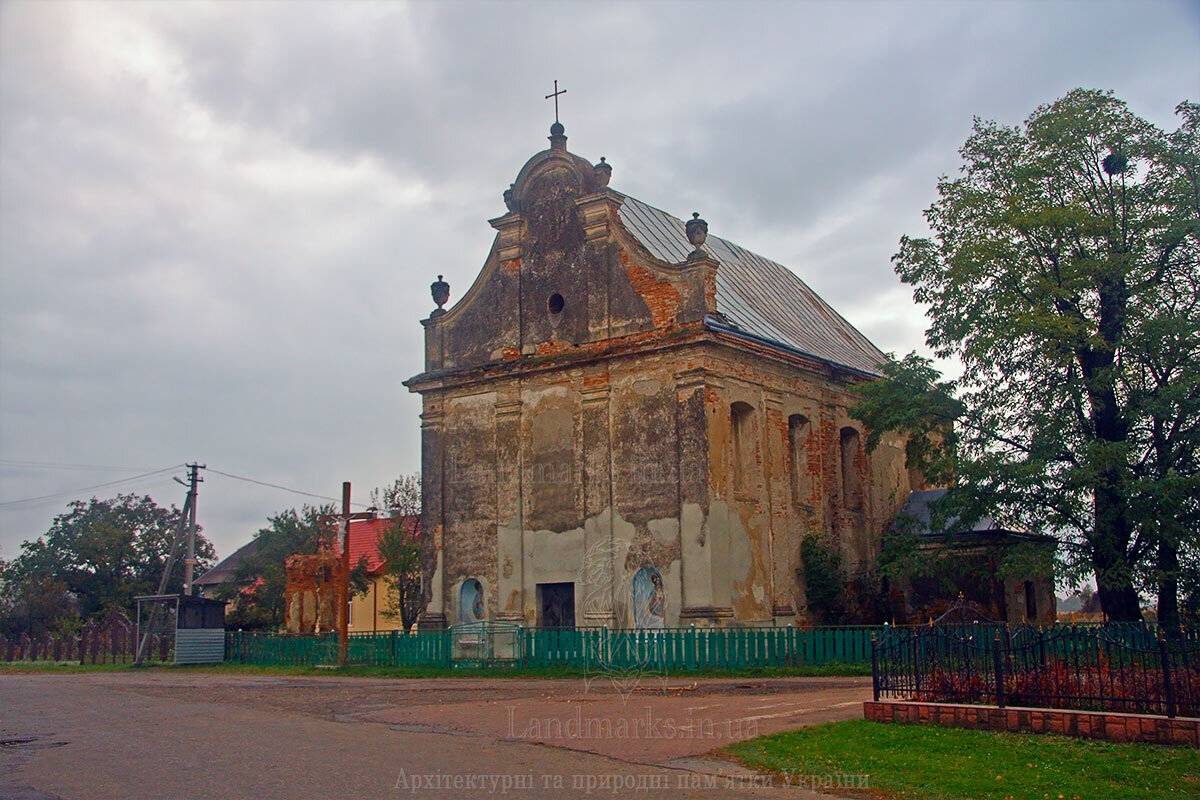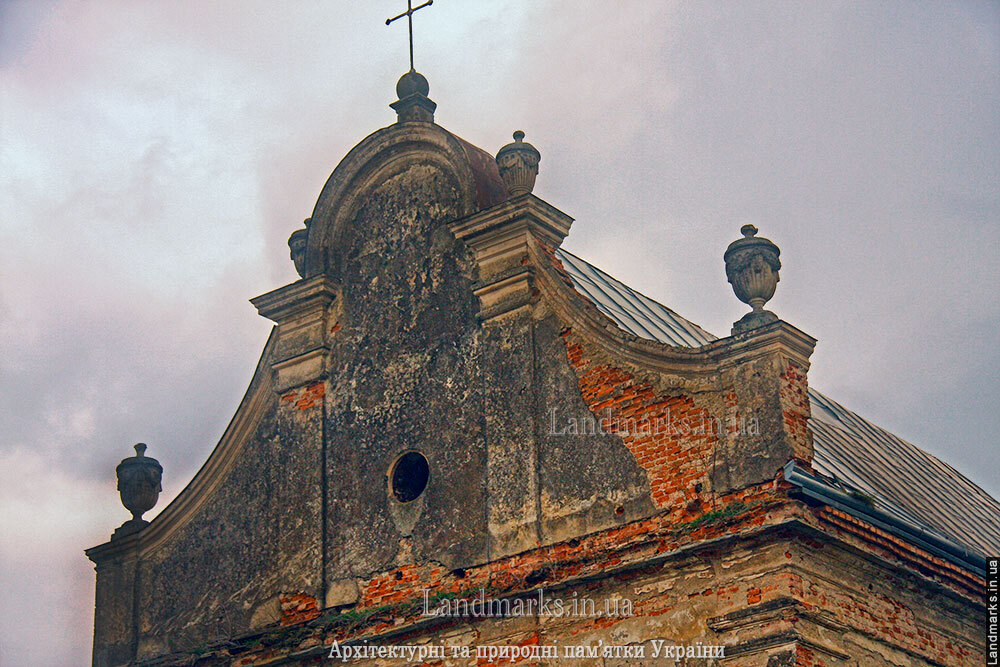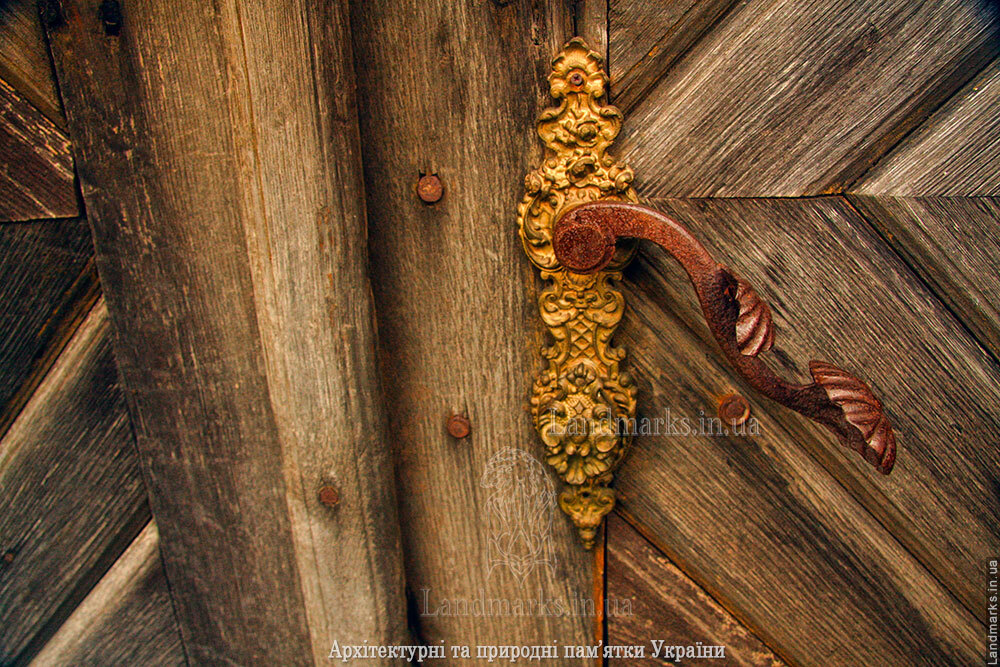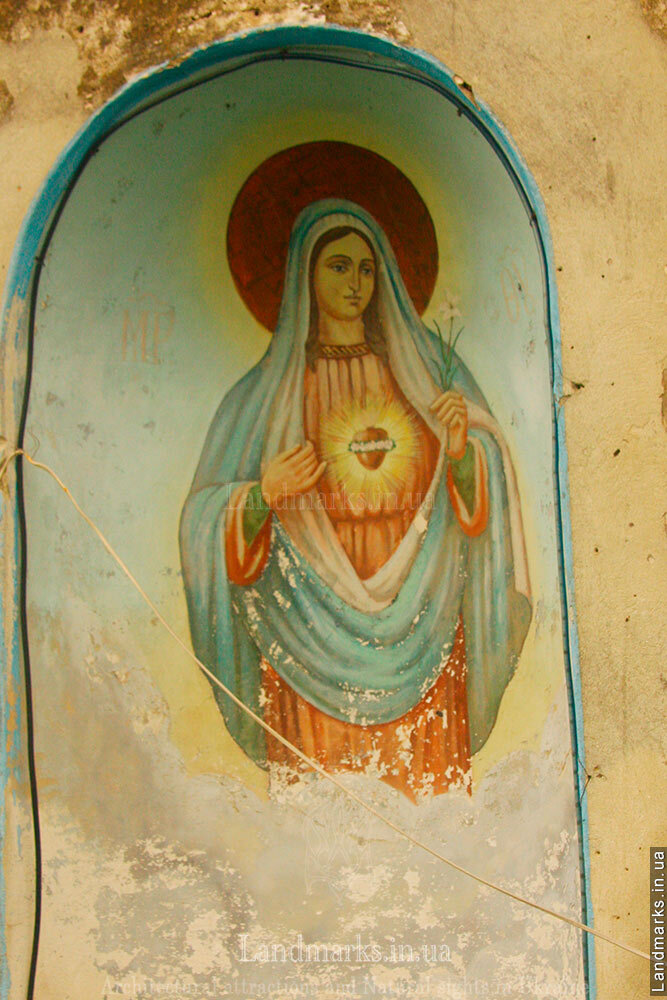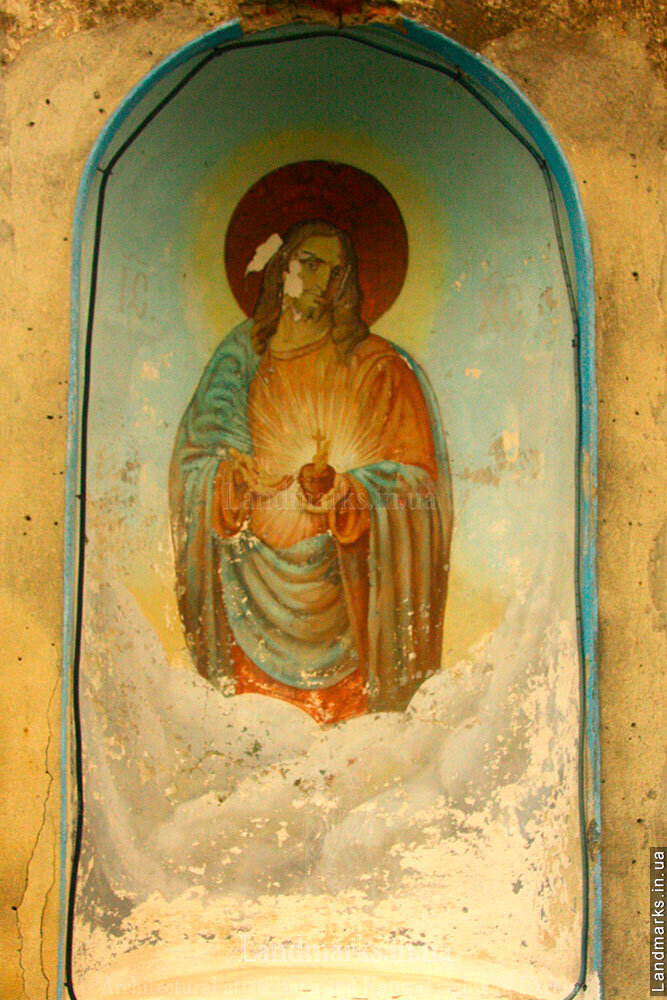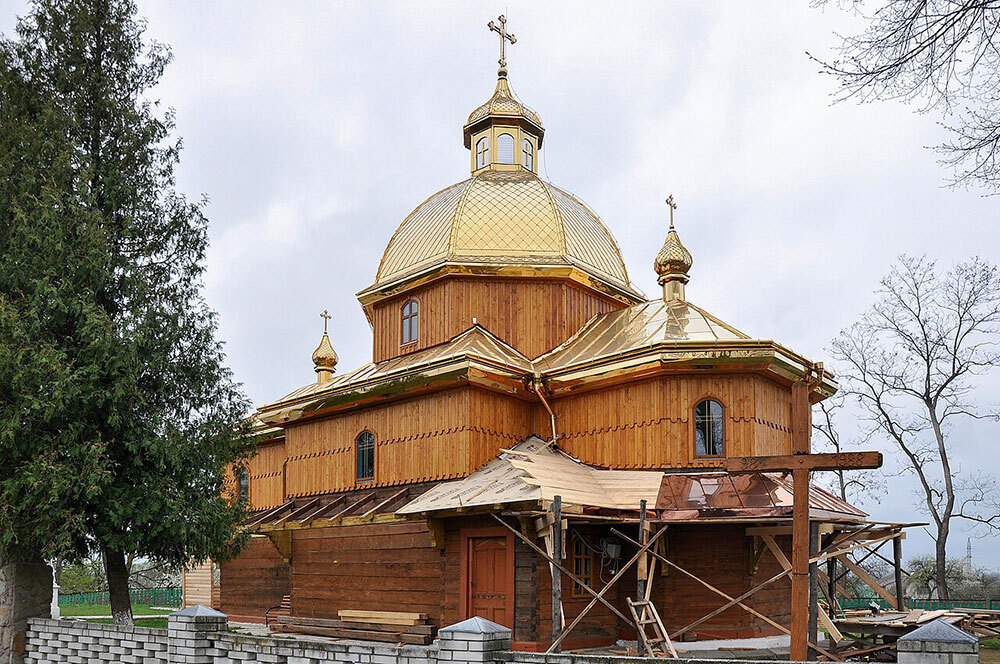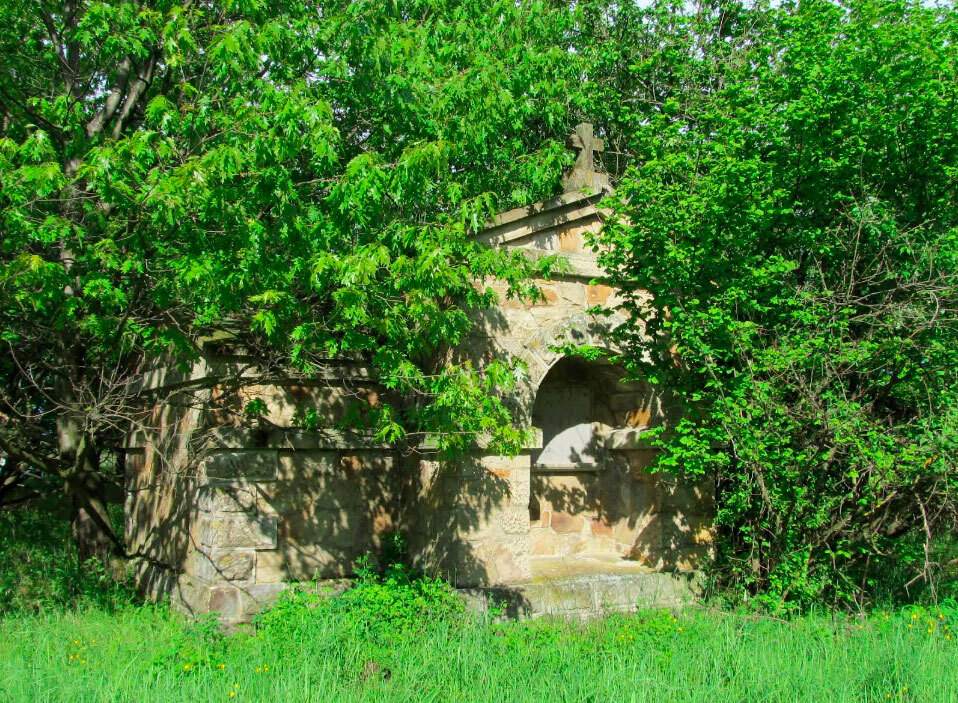Zhulyn is located in a picturesque place - you can already see the mountains from there - the foothills of the Carpathians.
The village is situated near the Lviv-Mukachevo highway, in 12 kilometres from the city of Stryi.
It is recommended to visit the village to see two architectural and historical monuments.
Church of Assumption of Virgin Mary
The church in Zhulyn was built between 1797 and 1802 at the expense of the village's headman, the Volyn castellan Franciszek Młocki.
During the period of Soviet Ukraine, after the Second World War, the church was used as a mineral fertiliser storage facility. This usage, of course, severely damaged the interior of the church. The walls absorbed the poisonous smell of chemicals, and even now, after all these years, you can still feel the unpleasant smell. In 2020, the Greek Catholic community of the village installed glass in the windows of the building. Some church items, such as icons and crucifixes, were moved from the church to the Greek Catholic Church.
The church has a very interesting history. An icon was brought here from Pidhirtsi - a copy of the icon ‘Salus Populi Romani’ (‘Salvation of the Roman People’), the original of which dates back to the sixth century and is now kept in the Italian cathedral of Santa Maria Maggiore. This icon is considered the main icon of the Virgin Mary in Rome. The holy relic is of Eastern origin and belongs to the iconographic type of the Hodegetria. Traditionally, this image is associated with the miracle of snow and is often called the Madonna of Snow or Mary of the Snow.
So, as for the copy, which is also considered to be miraculous and had 9 silver vestments and several bags of gifts (mostly gold items given to the icon by the faithful as a thanksgiving for healing). When the Church of the Assumption of the Blessed Virgin Mary was consecrated (in 1802) and until the arrival of the Soviet regime, this version of the Salus Populi Romani (Salvation of the Roman People) was kept in the church. Later, the icon, along with some other items from the church, was moved to a wooden church, where a museum was created in Soviet regime . The placement of the museum in the church saved the church from disfigurement, destruction and marauding, in fact almost everything, including the iconostasis, remained in the church!
Not so long ago, when the priest of the church, Father Oleh Korda, decided to restore the wooden church (we will mention it later), the work got to the interiors, and then the restoration specialists found this image in the iconostasis. It was hidden under five layers of paint! The restoration of the icon had lasted for a year. In this way, one icon connected two churches in the village, and was miraculously rediscovered and restored.In 2018, the church had a miraculously preserved praise chest with the inscription: "Eternal home. Annychka, who became famous for her desire to fight in the century. She was buried here on 16 February 1817." I do not know who this strong Annichka was.
A wooden cross with a crucifix was installed near the church. The church building seems to have been given to the Greek Catholic community of the village.
Interestingly, there is a village of the same name in Poland, Zhulyn, with a church that was an Orthodox shrine and is now a Roman Catholic church.
The frontage is made in the Baroque style, rather modest, the pediment of the church is decorated with pilasters around the perimeter, with four windows on the sides between them, and contains a round window on the facade - a rose window, also the pediment is decorated with four vases, and the top is crowned with a cross. Below, to the right and left of the entrance, the façade has niches with images of the Blessed Virgin Mary and Jesus Christ. They were probably made much later. Before that, the niches could have originally contained sculptures of saints. (If someone knows exactly what it was before, correct me)
Church of the Holy Trinity
Zhulyn has an architectural object of local importance - the wooden church of the Holy Trinity. The church belongs to the Greek Catholic parish and was built in 1892 on the place of the older church of the Holy Great Martyr Paraskeva.
The church has three log frames, vestries are attached to the altar on both sides, a porch is attached to the south-west side of the chancel, and an extension of unknown purpose is attached to the north-west side. The church is surrounded by a canopy. The low light octagon above the nave is covered with a cupola, which is completed by a large blind lantern with a top. To the south of the church stands a two-tiered bell tower (apparently made of stone).
The first written mentions of the parish in Zhulyn are recorded in 1507 and 1515. I don't know when the church preceding the present one was built, but according to the website http://decerkva.org.ua/, the church was already marked on the map Galizien und Lodomerien (1779-1783) - First Military Survey. In the 19th century, the church was in poor state, and it was repaired, and initially it was planned to build a new one, but the construction of the new one was postponed for more than half a century thanks to the craftsmen.
When the new rector of the parish, Oleh Korga, arrived (parish page), the church was covered with plastic panels that were harmful to wood, and some of the images were repainted. On his initiative, the parish decided to get rid of the clapboard and re-roof the church. He also decided to restore the interior, as the walls inside were plastered and painted, to its original wooden appearance, and to restore the icons and iconostasis. It was thanks to this initiative that the miraculous icon, which was moved from the catholic church in Zhulyn and before had previously been in Pidhirtsi as the church icon of the old church, was discovered. So, the only pity is that the church has ‘golden domes’, which are not typical for Ukrainian architecture. I wish the church would get a real roof, probably a shingle roof.
I didn't take a photo of the church, so I'll borrow one from Wikipedia for now
Zhulyn also has a Way of the Cross (imitations of the Via Dolorosa) consisting of 15 stations and 14 crosses.
A burial mound from the end of the third and beginning of the second millennium BC was discovered between villages Zhulyn and Semyhinove, which belongs to the Carpathian culture centred in Kavsk.
There was a castle in Zhulyn, but not even a relief remains.
 Historical background (compiled by me from Wikipedia)
Historical background (compiled by me from Wikipedia)
The village was founded in 1466, although there are versions of an earlier date. The written references to the village of Zhulyn date back to 1482, 1495, 1504 and are contained in tax registers. The owner of the land is indicated in the documents as a nobleman Juchno Nagwazdan ze Stańkowa, who in 1482 sells his property to Rafał Leszczyński. (Grzegorz Jawor, Osady prawa wołoskiego i ich mieszkańcy na Rusi Czerwonej w późnym średniowieczu, Lublin 2000, s. 212, 223)In the early seventeenth century, the owner of Zhulyn was Mikołaj Staniński (Studia nad zamkami i dworami ziemi przemyskiej od płowy XIV do początków XVIII wieku).
In the period between 1620-1622, the Tatars burned the village, killed some of the inhabitants, and took the rest (600 according to some sources) captive. Gradually, Zhulyn revived. The villagers were engaged in agriculture, animal husbandry, crafts, and fishing. Since 1638, the estate was owned by Andrzej Krzeczkowski (Andrzej Krzeczkowski). Later, Zhulyn belonged to Karol Stanisław Gidziński, who significantly strengthened the Zhulyn castle and built fortifications around the entire settlement (Łoziński Władysław. Prawem i lewem. - Lwów, 1931.) In 1790, the Austrian emperor granted Zhulyn the status of a town with a magistrate and annual fairs. In 1797, the owner of Zhulyn was the Volyn castellan Franciszek Młocki, after whose death Zhulyn passed to his son Kazimierz, and then to his grandson Franciszek.
During the eighteenth and early nineteenth centuries, local peasants rafted wood down the Stryi River to build riverboats. There used to be a saltworks where table salt was boiled from salt springs in the village. In the early nineteenth century, an iron blast furnace was built in Zhulyn, which operated until the middle of the century. The villagers also traded and worked in the city of Stryi.
In the beginning of the XX century, the village was owned by the widow Klotylda Baranska of Lodz (Klotylda z d. Łodyńskich Barańska h. Ślepowron). The last owner of Zhulyn until 1939 was her son, Włodzimierz Walery Tadeusz Baranski, a forestry engineer, owner of the Semyhyny and Rozgirce forest estates, and a member of the Society of Fox Hunters. He suffered a tragic fate, so as like his brother: arrested in 1939, imprisoned in Stryi, then was in Drohobych, and was shot in Bykivnia. His name was on the same list as his brother's, and the fate of Gisela Baranska is unknown. The Baranski family crypt has been preserved in the local cemetery.
Фото та текст Landmarks.in.ua
Якщо ви бачите, що інформація на цій сторінці неточна або неповна, значить ви знаєте більше. Тож допоможіть, поділіться знаннями. Напишіть лист з уточненнями чи зауваженнями або цікавими фактами про це місце на адресу:landmarks.in.ua@ukr.net Якщо ж ви побачили орфографічні помилки або одруківки, теж пишіть - я виправлю.
Також, велике прохання, будь ласка поважайте мою працю. Не вартує красти ані фото, ані тексти. Я попередила.
